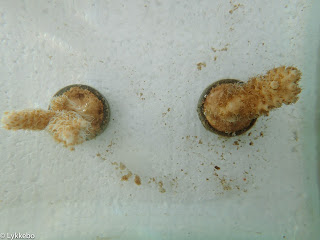Dealing with jetlag and acclimating to the 40 *C desert was done by working 10-12 hours every day and half of that outside in the heat! For this poor Scandinavian that meant a whole lot of sweating!
But - much was accomplished this first week !
A few weeks back corals were collected for my experiment and was chipped in to fragments and put in tanks. All ready to be played with! However, no one had kept and eye on them since, so I arrived to every aquarium-enthusiast's worst nightmare:
 | |
| Lovely coral-poop and algae infested tank |
So to all of you who might think Science is this mystic and high-tech field - nah-a! Our tools for cleaning the tanks: credit cards, sponges and plastic tubes for sucking out water.
With 9 tanks to clean it took us several hours before they were shining again. But It was evident that the little poopers were happy again!
 |
| Before and after.. |
 |
| Happy little poopers |
Now that the worst of the cleaning is done, only a daily short "vacuum" is needed to collect the coral poop. For yes, even Queens poop and therefor also corals! To minimize the algae growth their poop has to be sucked up everyday.
 |
| Coral poop |
With all this aside I could start getting the experiment set up. Which means, setting up water pumps, creating brine, organizing sampling times, equipment etc. With help from Edo and Eyal, everything got prepped and done this Wednesday and Thursday at noon the experiment was official up and running! So now there are three tanks flowing with normal seawater, three flowing the higher salinity seawater and three with high salinity and specific chemicals.
 |
| Edo and Eyal setting up the water flow |
 |
| Adina inspecting the 1000L water tank - always ready for a photo-op! |
With all the different corals and treatments I'm collecting 27 corals each sampling time. The sampling process is then a 6-7 hour long process with 5 people working non-stop. Luckily, I only have 3 sampling times.
 |
| Coral grave yard |
 |
| Living Acropora sp. |
This very morning, coming in to clean the tanks a lot of stuff had happened over night! The tanks with salt and chemicals had shown a major response to the treatment! Most of the corals were dead or dying! But that is a whole other story and I will leave that as a cliff hanger..
Stay tuned to learn about the fate of the little poopers !

Thanks you for sharing such great information about شركة نقل عفش بجدة
ReplyDelete